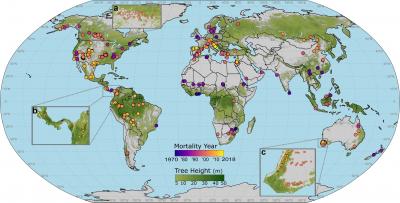Global Field Observations of Tree Die-Off Reveal Hotter-Drought Fingerprint for Earth’s Forests
The study established a geo-referenced global database documenting climate-induced mortality events spanning all tree-supporting biomes and continents, from 154 peer-reviewed studies since 1970.
The study established a global “hotter-drought fingerprint” from tree-mortality sites—effectively a hotter and drier climate signal for tree mortality—across 675 locations encompassing 1,303 plots. The frequency of these observed mortality-year climate conditions strongly increases nonlinearly under projected warming. The study also provides an initial footing for further community-developed, quantitative, ground-based monitoring of global tree mortality.
Earth’s forests face grave challenges in the Anthropocene, including hotter droughts increasingly associated with widespread forest die-off events. But despite the vital importance of forests to global ecosystem services, their fates in a warming world remain highly uncertain. Lacking is a quantitative determination of commonality in climate anomalies associated with pulses of tree mortality—from published, field-documented mortality events—required for understanding the role of extreme climate events in overall global tree die-off patterns.

